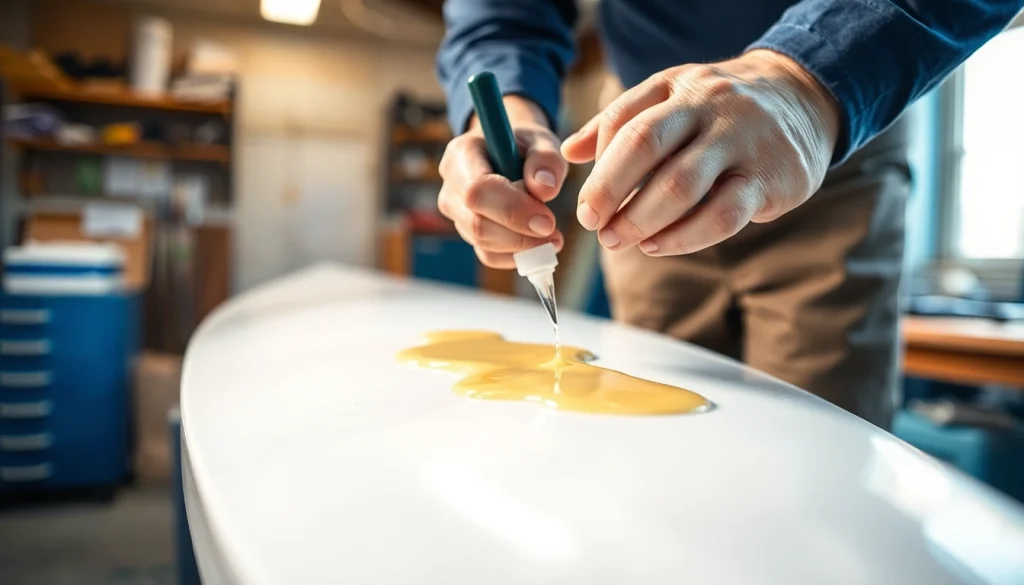Introduction to Laminating Resin
Laminating resin plays a pivotal role in various industries, especially in the fabrication of composite materials. This versatile compound is fundamental in creating strong, durable, and lightweight products used in aerospace, automotive, marine, and even artistic applications. Understanding the fundamentals of laminating resin can significantly enhance production quality and product longevity.
What is Laminating Resin?
Laminating resin is a type of synthetic polymer designed to bond layers of materials together, typically fiberglass, carbon fiber, or aramid fiber. Its primary function is to provide adhesion and structural integrity, making it an essential component in composite manufacturing. Available in both polyester and epoxy formulations, laminating resins offer unique properties suitable for different applications.
Importance in Composite Manufacturing
The significance of laminating resin in composite manufacturing cannot be overstated. It acts as the glue that holds together various material layers, allowing manufacturers to create composites that exhibit superior strength-to-weight ratios. This characteristic is especially vital in industries like aerospace, where performance and efficiency are paramount. The ability of laminating resin to form a solid bond also ensures stability and durability under extreme conditions, making it invaluable for creating critical components.
Key Properties of Laminating Resin
Understanding the properties of laminating resin helps manufacturers select the right type for their specific needs. Key properties include:
- Viscosity: Determines how easily the resin can be applied and how well it penetrates the fabric.
- By curing temperature: Critical for controlling the workspace and the time available for working with the resin.
- Adhesive strength: Essential for ensuring a strong bond between layers.
- Flexibility: Affects how the final product behaves under stress.
- Resistance to chemicals and UV radiation: Important for longevity in harsh environments.
Types of Laminating Resin
Polyester Laminating Resin Overview
Polyester laminating resin is known for its affordability and versatility. It is a popular choice in the marine industry for applications such as boat hulls and components due to its excellent adhesion and moisture resistance. This resin typically cures quickly, making it ideal for production environments where time is of the essence. Its lower viscosity allows for easier application and better wet-out of fiberglass fabric, resulting in a stronger bond.
Epoxy Laminating Resin Features
Epoxy laminating resin, on the other hand, is often preferred for its superior mechanical and thermal properties. Often utilized in high-performance applications, epoxy offers enhanced bonding strength, which translates to superior durability and resistance to environmental factors. While it tends to be more expensive than polyester resin, its performance benefits justify the cost in many applications, especially in the aerospace and automotive sectors.
Comparing Polyester and Epoxy Laminating Resins
When choosing between polyester and epoxy laminating resins, several factors should be considered:
- Cost: Polyester resins are generally cheaper, making them suitable for budget-conscious projects.
- Performance: Epoxy resins typically offer better performance in terms of strength, adhesion, and resistance to chemicals.
- Working time: Polyester has a faster curing time, which may be advantageous in certain manufacturing settings.
- Post-curing needs: Epoxy often requires a post-curing step for optimal performance, adding time to the process.
Applications of Laminating Resin
Marine Industry Uses
In the marine industry, laminating resin is predominantly used for constructing and repairing boats and ships. The resin forms a strong bond between layers of fiberglass, providing the necessary strength and rigidity to withstand harsh ocean conditions. Its water-resistant properties ensure that vessels remain buoyant and functional over time. Additionally, it is widely applied in creating molds and tooling for marine components.
Aerospace and Automotive Applications
The aerospace sector employs laminating resins for manufacturing lightweight, strong components that meet stringent safety regulations. In the automotive industry, it enhances the design and performance of parts, contributing to the production of lighter and more fuel-efficient vehicles. Laminating resins play an essential role in producing everything from body panels to structural components within modern transport vehicles.
Art and Craft Projects with Laminating Resin
Beyond industrial applications, laminating resin proves invaluable in art and craft projects. Artists utilize it to create stunning visual effects in composite art pieces, encapsulating objects in resin for protection and aesthetic appeal. Crafters value its versatility for making custom crafts, including jewelry and decorative items. Its ability to cure clear allows for unique design possibilities.
Best Practices for Laminating Resin Usage
Preparation and Mixing Techniques
Successful laminating resin applications begin with meticulous preparation. It’s vital to ensure that all surfaces are clean and free of dust or grease. When mixing resin components, precise measurements are crucial to achieving adequate curing and performance characteristics. This often involves following manufacturer guidelines for mixing ratios and ensuring that the mixture is homogeneous.
Application Tips for Optimal Results
To achieve the best results with laminating resin, consider the following tips:
- Layering: Apply multiple thin layers rather than a single thick layer to ensure even curing and better adhesion.
- Environment control: Maintain optimal temperature and humidity in the workspace to enhance curing phenomena.
- Techniques: Use brushes or rollers specifically designed for resin application to prevent contamination and achieve better results.
- Timing: Be aware of the working time and gel time to maximize application efficiency before the resin begins to set.
Post-Application Care and Curing
Post-application care is vital for achieving the best performance from your laminating resin. Ensure that the resin cures in a suitable environment, away from moisture and contaminants. After the curing period, inspect for any imperfections or bubbles, and sand or polish as necessary for a smooth finish. Proper maintenance post-application will not only enhance the aesthetic quality but also extend the longevity of the final product.
Common Challenges and Troubleshooting
Issues with Curing and Adhesion
Problems with curing are among the most common issues encountered when using laminating resins. Factors such as incorrect mixing ratios, inadequate temperature, or humidity can hinder the curing process. Should a failure in adhesion or curing occur, it’s often beneficial to evaluate the environmental conditions and the mixing process. If necessary, a secondary application might be needed to ensure adherence.
Common Contamination Problems
Contamination from dust, oils, or moisture can lead to undesirable results, including poor adhesion and bubbles. To mitigate contamination risks, it’s crucial to work in a clean environment and handle materials with care. Employing proper PPE (Personal Protective Equipment) and ensuring tools and surfaces are clean before application are effective strategies for preventing contamination-related issues.
Solutions for Working with Laminating Resin
To work effectively with laminating resin, consider implementing the following solutions:
- Testing: Conduct small-scale tests to determine the behavior of the resin under specific conditions before full-scale applications.
- Documentation: Keep detailed records of your processes, including resin types, mix ratios, environmental conditions, and application techniques.
- Education: Stay informed about advancements and best practices in resin technology through workshops, courses, and online resources.





